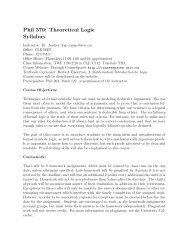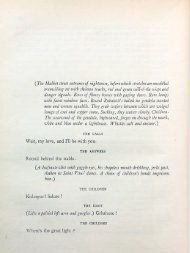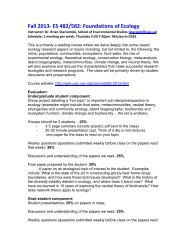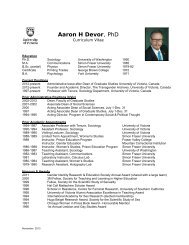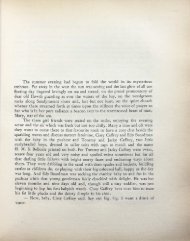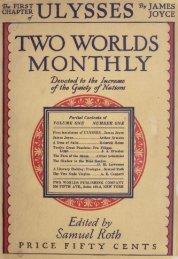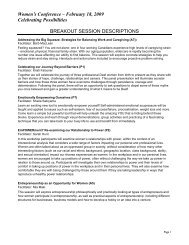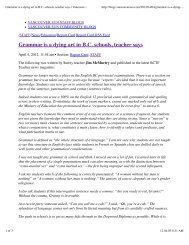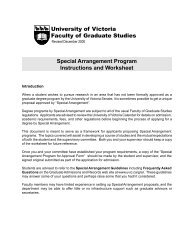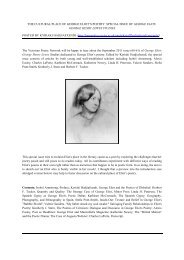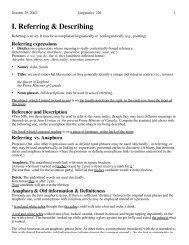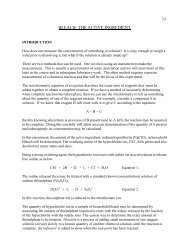"Architecture or Revolution": Taylorism, Technocracy, and Social ...
"Architecture or Revolution": Taylorism, Technocracy, and Social ...
"Architecture or Revolution": Taylorism, Technocracy, and Social ...
Create successful ePaper yourself
Turn your PDF publications into a flip-book with our unique Google optimized e-Paper software.
<strong>Social</strong> Democratie: Un projet urbain ideal no. 11/12, p. 1223.<br />
typique: agglomeration parisienne 1919-<br />
1939, Paris, Institut d'Etudes et de Recherches<br />
Architecturales et Urbaines, Ministere<br />
d l'Environment et du Cadre de Vie,<br />
C.O.R.D.A., 77 73 028 00 202 7501, n.d.<br />
48 The postwar "call to <strong>or</strong>der" is evident in<br />
both the political <strong>and</strong> cultural spheres. F<strong>or</strong> a<br />
discussion of the conservative reaction on<br />
the cultural sphere, see Universit6 de Saint-<br />
Etienne, Retour a l'<strong>or</strong>dre, <strong>and</strong> especially<br />
58 Alex<strong>and</strong>er de Senger, Le Cheval de troie du<br />
bolchevisme, Bienne, Editions du Ch<strong>and</strong>elier,<br />
1931.<br />
The best discussion of de Senger's text, as<br />
well as of Mauclair's L'<strong>Architecture</strong> va-t-<br />
40 Ge<strong>or</strong>ges Benoit-Levy, La F<strong>or</strong>mation de la Silver's excellent article, "Purism: Straight- elle mourir?, is still Gauthier's Le C<strong>or</strong>burace,<br />
Vichy, n.d., cited in Phillips, "New-<br />
C<strong>or</strong>p<strong>or</strong>atist Praxis," p. 406.<br />
41 Benoit-Levy, Paris s'entendu, Nice, Societe<br />
Generale d'Imprimerie, 1927, pp. 42-43;<br />
idem, La Cite-jardin, Paris, Jouve, 1904.<br />
La Cite-jardin predates the widespread introduction<br />
of Tayl<strong>or</strong>ism in France, but it<br />
relates directly to ideas of rationalization of<br />
production. Benoit-Levy opened the text<br />
with a quotation from the Le Play's Saint-<br />
Simonian text, L'Organisation du travail.<br />
He argued f<strong>or</strong> the need f<strong>or</strong> "ville modeles"<br />
to accompany "ateliers models." F<strong>or</strong><br />
ening Up after the Great War," Artf<strong>or</strong>m 15,<br />
no. 7 (March 1977), pp. 56-63; also his<br />
dissertation, "Esprit de C<strong>or</strong>ps."<br />
49 Many of the strongest advocates of European<br />
economic integration were advocates of industrial<br />
modernization. Loucheur served as<br />
president of the French Pan-Europe committee,<br />
<strong>and</strong> was followed upon his death in 1931<br />
by Mercier. Both were associates of Le C<strong>or</strong>busier,<br />
as was the internationalist Paul Otlet,<br />
Le C<strong>or</strong>busier's client f<strong>or</strong> the Mundaneam.<br />
The Pan-Europe movement was founded<br />
after W<strong>or</strong>ld War I by Count Coudenhovesier.<br />
See also Jacques Gubler, Nationalisme<br />
et internationalisme dans l'architecture<br />
modeme de la Suisse, Lausanne, L'Age<br />
d'homme, 1975.<br />
59 Le C<strong>or</strong>busier, Towards, p. 261.<br />
60 Paul Lafitte, "A propos de la Gr<strong>and</strong> Crise,"<br />
L'Esprit Nouveau no. 16, p. 1900.<br />
61 Ibid., p. 1889.<br />
62 Hertz, "Balbutiements de l'esprit politique<br />
III," L'Esprit Nouveau no. 24; Jean Lurgat,<br />
"Le Cartel des Ind6pendants," ibid.<br />
Benoit-Levy's influence on Le C<strong>or</strong>busier,<br />
see Paul V. Turner, "The Education of Le<br />
C<strong>or</strong>busier: A Study of the Development of<br />
Le C<strong>or</strong>busier's Thought, 1900-1920," dissertation,<br />
Harvard University, 1971, pp.<br />
129-33.<br />
42 Fayol, Management, p. 96. During the war,<br />
Le C<strong>or</strong>busier studied at the Bibliotheque<br />
Nationale Alfred de Foville's L'Enquete sur<br />
les conditions de l'habitation en France, Les<br />
Maisons Types, Paris, 1894. The book, utilizing<br />
Foville's research with the Section des<br />
Sciences Economiques et <strong>Social</strong>es du Comit6<br />
des Travaux Hist<strong>or</strong>iques et Scientifiques of<br />
the Musee <strong>Social</strong>, is an early illustration of<br />
social engineering. In contrast to earlier<br />
academic studies such as Charles Gamier's<br />
L'Habitation humaine, the book proposes a<br />
new scientific <strong>and</strong> statistical approach to<br />
design; implicit is a notion of potential social<br />
ref<strong>or</strong>m. See Gregh, "The Dom-ino Idea,"<br />
p. 82; Tayl<strong>or</strong>, Pessac, p. 1.<br />
43 Devinat, Scientific Management, p. 78;<br />
Dubreuil, St<strong>and</strong>ards, pp. 10-11.<br />
44 Le C<strong>or</strong>busier published Perret's drawings<br />
f<strong>or</strong> a concrete house in "Maison en Serie"<br />
<strong>and</strong> Gamier's Cit6 Industrielle" in "Trois<br />
rappels a MM. les Architectes," Esprit<br />
Nouveau no. 4. Perret's drawings, however,<br />
were omitted in Vers une architecture.<br />
Kalegi, a European nobleman of international 63 Hertz, L'Esprit Nouveau no. 24.<br />
ancestry. See Richard F. Kuisel, Ernest<br />
64<br />
Mercier, French<br />
Maier, "Between<br />
Technocrat,<br />
Tayl<strong>or</strong>ism <strong>and</strong> Technoc-<br />
Berkeley,<br />
University of Calif<strong>or</strong>nia Press, 1967, p. 73.<br />
racy," p. 38.<br />
F<strong>or</strong> the broader w<strong>or</strong>ld vision of French Tay- 65 Le C<strong>or</strong>busier, Towards, p. 254.<br />
l<strong>or</strong>ists, see Merkle, Managment <strong>and</strong> Ideol-<br />
66 Le<br />
ogy, p. 137.<br />
C<strong>or</strong>busier, "La Gr<strong>and</strong> Ville," L'Esprit<br />
Nouveau no. 23, in Le C<strong>or</strong>busier, City, p.<br />
50 Le C<strong>or</strong>busier, "Nos moyens," L'Esprit 102.<br />
Nouveau no. 27, in Le C<strong>or</strong>busier, City, p.<br />
67 La Direction, "Ce<br />
140.<br />
que nous avons fait, ce<br />
que nous ferons," L'Esprit Nouveau no.<br />
51 Ibid., pp. 147-48,296.<br />
11/12, pp. 1212, 1213.<br />
52 Camille Mauclair, L'<strong>Architecture</strong> va-t-elle 68 L'Esprit Nouveau no. 11/12, p. 1372; ibid.<br />
mourir? La crise du "panbetonnisme inte- no. 10, p. 1202.<br />
gral," Paris, Nouvelle Revue Critique, 1933,<br />
69 Francis<br />
p. 38.<br />
Delaisi, "Faut-il emettre 150 milliards<br />
de billets de banque?" L'Esprit Nou-<br />
53 The association of f<strong>or</strong>ms with national iden- veau no. 8, pp. 927-934; see also n. 43<br />
tity <strong>or</strong> patriotic allegiance was most common above. Le C<strong>or</strong>busier wrote in Urbanisme, p.<br />
throughout W<strong>or</strong>ld War I <strong>and</strong> the 1920s. 277, that he had hoped to give the chapter<br />
Ozenfant in his article in L'Esprit Nouveau "Chiffres" to Francis Delaisi to write.<br />
on Villa Schwob (1916) addressed this issue:<br />
70 Le<br />
"even nationalism has become mixed<br />
C<strong>or</strong>busier, City, pp. 251-72, 302.<br />
up<br />
with it <strong>and</strong> certain fine spirits have decreed 71 Le C<strong>or</strong>busier, Urbanisme, p. 285. This<br />
that the straight line is German (witness the phrase does not appear in Etchell's translation.<br />
Pantheon, the Egyptian temples, <strong>and</strong> palaces<br />
72 Le<br />
of Gabriel). The straight line is one of the<br />
C<strong>or</strong>busier, La Ville radieuse, Paris,<br />
L'<strong>Architecture</strong><br />
rights of man." (Julien Caron [pseudonym<br />
d'Aujourd'hui, 1935. Translated<br />
into<br />
f<strong>or</strong> Ozenfant], "Une Villa de Le C<strong>or</strong>bu-<br />
English by Pamela Knight, Elean<strong>or</strong><br />
sier," L'Esprit Nouveau no.<br />
Levieux, <strong>and</strong> Derek Coltman, in Le C<strong>or</strong>bu-<br />
6, pp. 679-704;<br />
Julien Caron, "Villa of Le<br />
sier, The Radiant City, New Y<strong>or</strong>k, Orion<br />
C<strong>or</strong>busier,"<br />
trans. Joan Ochman, Oppositions no.<br />
Press, 1964,<br />
15/16<br />
p. 120; idem, City, p. 256.<br />
45 Le C<strong>or</strong>busier, Towards, pp. 263-64.<br />
[Winter/Spring 1979] p. 187-97.) Later, in<br />
Urbanisme, Le C<strong>or</strong>busier also disputes<br />
claims that the straight line is German, Le<br />
C<strong>or</strong>busier, City, p. 23. See Silver, "Esprit<br />
de c<strong>or</strong>ps," f<strong>or</strong> an extended <strong>and</strong> perceptive<br />
discussion of art <strong>and</strong> national identity during<br />
this period.<br />
73 Benoit-Levy, Paris s'entendu, pp. 22-23.<br />
The translation is from Phillips, "New-<br />
C<strong>or</strong>p<strong>or</strong>atist Praxis," p. 405.<br />
74 Henri Hertz, "Balbutiements de l'esprit<br />
politique," L'Esprit Nouveau no. 21; "Balbutiements<br />
II," ibid. no. 22; "Balbutiements<br />
III," ibid. no. 24.<br />
Although Hertz found "impuretes" in the<br />
Radical Party, he believed that it was the<br />
only hope f<strong>or</strong> a renewal of "I'esprit publique.<br />
" Later Hertz wrote f<strong>or</strong> the communist<br />
review Europe.<br />
46 L'Esprit Nouveau, revue internationale<br />
hebdomadaire d'economique no. 1 (January<br />
1921). This was the only issue of this review<br />
dedicated to the discussion of "Economie<br />
politique, Economie nationale, Economie<br />
internationale, Science et Industrie, Meth-<br />
odologie." F<strong>or</strong> a discussion of L'Esprit<br />
Nouveau, see Robert Gabetti <strong>and</strong> Carlo<br />
Olmo, Le C<strong>or</strong>busier e l'Esprit Nouveau,<br />
Turin, Giulio Einaudi, 1975; Frangoise<br />
Will-Levaillant, "N<strong>or</strong>me et f<strong>or</strong>me a travers<br />
L'Esprit Nouveau," Universit6 de Saint-<br />
Etienne, Retour a l'<strong>or</strong>dre, pp. 241-76. An<br />
adequate analysis of the social <strong>and</strong> political<br />
ideas of the review remains to be done.<br />
47 N.D.L.R., note to R. Chenevier, "Wilson<br />
et l'humanisme franqais," L'Esprit Nouveau<br />
146 ArtJournal<br />
54 Erik Satie, "Cahiers d'un mammifere,"<br />
L'Esprit Nouveau no. 7, p. 833.<br />
55 R. Chenevier, "La Vie frangaise," L'Esprit<br />
Nouveau, no. 6, pp. 705-14; idem, "Wilson<br />
et l'humanisme frangais," ibid., no. 11/12,<br />
pp. 1223-30; idem "Ou meme la politique<br />
anti-sovietique," ibid., no. 9, pp. 1045-51.<br />
56 L'Esprit Nouveau, no. 16, p. 1969; Henri<br />
Hertz, "Lenine," ibid., no. 21.<br />
57 L'Esprit Nouveau, no. 15, p. 1727. See also<br />
Hertz, "Wilson," ibid., no. 22.<br />
75 Le C<strong>or</strong>busier, Towards, pp. 219, 245.<br />
76 Paul Dermee, "Andr6 Gide," L'Esprit<br />
Nouveau no. 25.<br />
77 The imp<strong>or</strong>tance of Proudhon to the L'Esprit<br />
Nouveau group is expressed in R. Chene-



